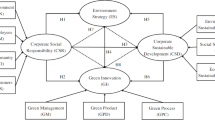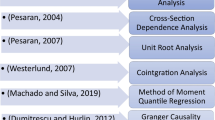Abstract
In this paper, green finance is incorporated into the theoretical framework of technological progress bias to investigate the internal mechanism of green finance influencing environmental technological progress bias and the cleaning of industrial structure. Quantitative analysis is carried out by parameter calibration and numerical simulation. The results show that the environmental technology progress bias has obvious path-dependent characteristics. By means of financing scale and financing cost, green finance influences the relative profit, R&D behavior choice and environmental technology progress preference of the two types of R&D firms and then influences the cleaning of industrial structure through direct productivity effect, indirect price effect and market size effect. Only when the proportion of financing scale of clean R&D departments or the interest rate subsidy exceeds a certain critical value, can green finance successfully induce the occurrence of clean technological progress and promote the cleanliness of industrial structure. However, when the proportion of financing scale or interest rate subsidy of clean R&D departments is lower than a certain critical value, the improvement effect of green finance on the output value of clean industry is offset by the effect of polluting technological progress, which is not conducive to the clean industrial structure.






Similar content being viewed by others
Data availability
The datasets generated during the current study are available from the corresponding author on reasonable request.
Notes
Note Data are from "China Ecological and Environmental Status Bulletin 2017".
Data from Environmental Performance Index 2018.
In this paper, the pollution emission intensity is taken as the classification standard, and the industries with less than the median pollution emission intensity are classified as clean industries, while the industries with more than the median pollution emission intensity are classified as polluting industries. Pollution emission intensity is calculated by calculating pollutant emissions (including industrial waste water, industrial sulfur dioxide and industrial solid waste) per unit of industrial output value of various industries over the years, and is weighted by equal weight after standardization.
Consider two kinds of situations: \(\varepsilon = 5\) and \(\varepsilon = 10\).
The greater the elasticity \(\varepsilon\) of substitution of clean and polluting intermediate products, the smaller the critical value will be. When \(\varepsilon = 5\), the critical value is 0.7789; When \(\varepsilon = 10\), the critical value is 0.7126.
Consider two kinds of situations: \(\varepsilon = 5\) and \(\varepsilon = 10\).
The greater the elasticity \(\varepsilon\) of substitution of clean and polluting intermediate products, the smaller the critical value will be. When \(\varepsilon = 5\), the critical value is 0.0278; When \(\varepsilon = 10\), the critical value is 0.0216.
References
Acemoglu, D., Aghion, P., Bursztyn, L., & Hemous, D. (2012). The environment and directed technical change. American Economic Review, 102(1), 131–166.
Chava, S., Nanda, V., & Xiao, S. C. (2017). Lending to innovative firms. The Review of Corporate Finance Studies, 6(2), 234–289.
Chung, Y. H., Fare, R., & Grosskopf, S. (1997). Productivity and undeairable outputs: A directional distance function approach. Journal of Environment Management, 51(3), 229–240.
Guo, R., & Former, Y. (2020). Environmental regulation, R&D subsidy and industrial structure upgrading. Studies in Science of Science, 38(12), 2140–2149.
Han, J., Chen, C., & Feng, K. (2014). Does environmental regulation promote industrial upgrading? From the perspective of industrial technological complexity. Journal of Beijing Normal University, 1, 148–160.
He, X. (2014). Research on optimal regulation structure of green technology innovation: Based on the interactive effect of R&D support and environmental regulation. Economic Management, 11, 144–153.
He, X., & Zhang, Y. (2012). Technology progress, energy save and emission reduce and development pattern transformation: An empirical study of 36 industries in China. The Journal of Quantitative & Technical Economics, 3, 19–33.
Jin, P., Zhang, Y., & Peng, X. (2014). The double-edged effect of technological progress in carbon dioxide emissions reduction: Empirical evidence from 35 sub-industrial sectors in China. Studies in Science of Science, 5, 706–716.
Jing, W., & Zhang, L. (2014). Environmental regulation, economic opening and China’s industrial green technology progress. Economic Research Journal, 9, 34–47.
Karanfil, F., & Yeddir-Tamsamani, Y. (2010). Is technological change biased toward energy? A multi-sectoral analysis for the french economy. Energy Policy, 38(4), 1842–1850.
Kheder, S. B., & Zugravu, N. (2012). Environmental regulation and french firms location abroad: An economic geography model in an international comparative study. Ecological Economics, 77, 48–61.
King, R. G., & Levine, R. (1993). Finance, entrepreneurship, and growth: Theory and evidence. Journal of Monetary Economics, 32(3), 513–542.
Lei, S. (2014). Dynamic mechanism of the environmentally sound technology innovation of environmental friendly enterprises: An exploratory research based on grounded theory. Journal of Management Case Studies, 8, 283–296.
Li, B., Peng, X., & Ouyang, M. (2013). Environmental regulation, green total factor productivity and the transformation of China’s industrial development mode: Analysis based on data of China’s 36 industries. China Industrial Economics, 4, 56–68.
Li, H., & Zou, Q. (2018). Study on environmental regulation, resource endowment and urban industrial transformation: A comparative analysis of resource-based cities and non-resource-based cities. Economic Research, 53(11), 182–198.
Liu, H., Liu, B., & Zheng, S. (2019). Environmental regulation and industrial transformation and upgrading: DID test based on the “Eleventh Five-Year Plan” emission reduction policy. China Soft Science, 5, 40–52.
Liu, J., & Xia, Y. (2015). The short medium and long term effects of green credit policy in china based on a financial CGE model. Chinese Journal of Management Science, 4, 46–52.
Luo, L., & Li, S. (2014). Technological progress, industrial structure and China’s industrial carbon emissions. Science Research Management, 6, 8–13.
Malerba, F., Nelson, R. R., & Orsenigo, L. (2006). Innovation and the evolution of industries: History-friendly models. Journal of Evolutionary Economics, 16(11), 3–23.
Ning, W., & She, J. (2014). An empirical study on the dynamic relationship between green finance and macroeconomic growth. Seeker, 8, 62–66.
Qian, S., & Zhou, Y. (2011). Financial development, technology progress and industrials upgrading. Statistical Research, 1, 68–74.
Solarin, S. A., Al-Mulali, U., Musah, I., et al. (2017). Investigating the pollution haven hypothesis in ghana: An empirical investigation. Energy, 124, 706–719.
Stiglitz, J. E., & Weiss, A. (1981). Credit rationing in markets with imperfect information. American Economic Review, 71(3), 393–410.
Tone, K. (2001). A slacks-based measure of efficiency in data envelopment analysis. European Journal of Operation Research, 130(3), 498–509.
Wan, G., Tao, Y., & Ye, L. (2019). Environmental regulation, industrial transformation and high quality development of Anhui Economy. East China Economic Management, 33(11), 24–29. in Chinese.
Wang, Y., Pan, D., & Zhang, X. (2016). Research on green finance’s contribution to China’s economic development. Comparative Economic & Social Systems, 11, 33–42.
Yan, Z., Deng, X., & Chen, B. (2016). The impact of green technology progress on the low-carbon transformation of China’s industrial structure. Comparative Economic & Social Systems, 4, 25–39.
Yi, X., & Liu, F. (2015). Financial development, technological innovation and industrial structure transformation: The theoretical framework of multisectoral endogenous growth. Management World, 10, 24–39.
Zhang, J. (2016). The influence of directing environmental policies on the technology selection and TFP of Chinese power generation companies. Journal of Finance and Economics, 4, 134–144.
Zhang, J., & Chen, S. (2021). Financial development, environmental regulation and economic green transformation. Research of Finance and Economics, 47(11), 78–93. in Chinese.
Zheng, F., & Li, J. (2021). Science and technology environmental regulation forced industrial transformation and upgrading of resource-based cities: Theoretical model and dual effect analysis. Soft Science, 35(12), 22–28.
Funding
The study is supported by Natural Science Foundation of China (Grants No. 71673136).
Author information
Authors and Affiliations
Contributions
XLIU contributed to conceptualization, data curation, methodology, and writing—original draft. YZ contributed to writing—review and editing—and software.
Corresponding author
Ethics declarations
Conflict of interest
The authors declare they have no financial interests.
Additional information
Publisher's Note
Springer Nature remains neutral with regard to jurisdictional claims in published maps and institutional affiliations.
Rights and permissions
Springer Nature or its licensor (e.g. a society or other partner) holds exclusive rights to this article under a publishing agreement with the author(s) or other rightsholder(s); author self-archiving of the accepted manuscript version of this article is solely governed by the terms of such publishing agreement and applicable law.
About this article
Cite this article
Liu, X., Zhang, Y. Green finance, environmental technology progress bias and cleaner industrial structure. Environ Dev Sustain 26, 8643–8660 (2024). https://doi.org/10.1007/s10668-023-03062-x
Received:
Accepted:
Published:
Issue Date:
DOI: https://doi.org/10.1007/s10668-023-03062-x




